Falling Oil Prices Threaten Iran’s Nuclear Programme

Falling oil prices and the threat of sanctions have given the P5+1 (the five permanent members of the UN Security Council and Germany) greater negotiating power in their talks with Iran. Iran needs to reach an agreement by 24 November to avoid further sanctions on its economy, which is already suffering from a combination of low international oil prices and a lack of sales due to previously-imposed sanctions.
Background
Iran holds the fourth-largest oil reserves in the world and the second-largest reserves of gas, making it potentially the second-largest economy in the Middle East. The recent drop in the price of oil, however, along with continuing US and EU sanctions is threatening President Hassan Rouhani’s promise of a prosperous middle class in Iran. Sanctions on Iran have caused Iran’s oil revenue to drop by 47 per cent in 2012/2013. Oil prices further dropped from US$92 a barrel to US$80 within 30 days in October, causing a further 30 per cent drop in Iran’s oil revenue. This has put considerable pressure on Tehran to negotiate a nuclear deal with the P5+1 to lift sanctions which are crippling its economy.
Comment
In response to the recent developments in Iran’s oil economy, Rouhani has noted the need to deal with new conditions in the global economy. Iran is heavily dependent on oil exports, with petroleum exports making up around 23 per cent of its GDP. In order for the Iranian government to maintain a balanced budget, oil prices need to be around US$140 a barrel. Iran needs a significant boost to its oil revenue in order to facilitate economic growth, and this can only be achieved if sanctions are lifted on Iran’s oil exports. Some of these sanctions have been recently lifted, which have allowed for some non-oil growth. On 24 November, 2013, a Joint Plan of Action (JPOA) was established between Iran and the P5+1. Under this plan, Iran agreed to scale back its nuclear activities in exchange for some sanction relief during negotiations. The lifting of these sanctions helped the inflation rate in Iran to decrease from 40 per cent in September 2013 to 21 per cent in September 2014 as well as achieve a 4.6 per cent growth rate in the first quarter of 2014. The sanction relief will expire on 24 November however, and negotiations will end, putting pressure on the Iranian government to reach an agreement quickly.
A recent FDI Strategic Analysis Paper written by Michael Petrut provided a detailed analysis of Iran’s nuclear programme. In the paper, numerous factors were noted that suggest possible intentions for weapons development, including high enrichment levels, excessive stockpiling of enriched uranium and a lack of expertise and infrastructure to effectively produce electricity from uranium. A report conducted by the Institute for Science and International Security has also noted the involvement of an ex-Soviet nuclear weapons expert in developing an implosion system for Iran prior to 2004. Due to the likelihood that Iran has intentions to weaponise its nuclear programme, any agreements made by the P5+1 must include measures to ensure that nuclear infrastructure within Iran can only be used for the production and distribution of electricity. One way to achieve this would be to ensure that uranium for Iran’s nuclear reactors is enriched outside of Iran and sent back in plate form, making it difficult to weaponise.
If Iran does have strong intentions to weaponise its nuclear programme, it is unlikely that a successful agreement under the P5+1 negotiations will be achieved. It is however, in Iran’s best interest to reach an agreement quickly. If its oil economy continues to suffer under sanctions and low international oil prices, the capacity to achieve nuclear power will be diminished. Falling oil prices have given the P5+1 greater negotiating power, exacerbating the threat of further sanctions on Iran. It is up to the Supreme Leader Ayatollah Ali Khamenei to accept the best deal his negotiators can achieve.
Jarryd de Haan is part of the Indian Ocean Research Programme at Future Directions International.


